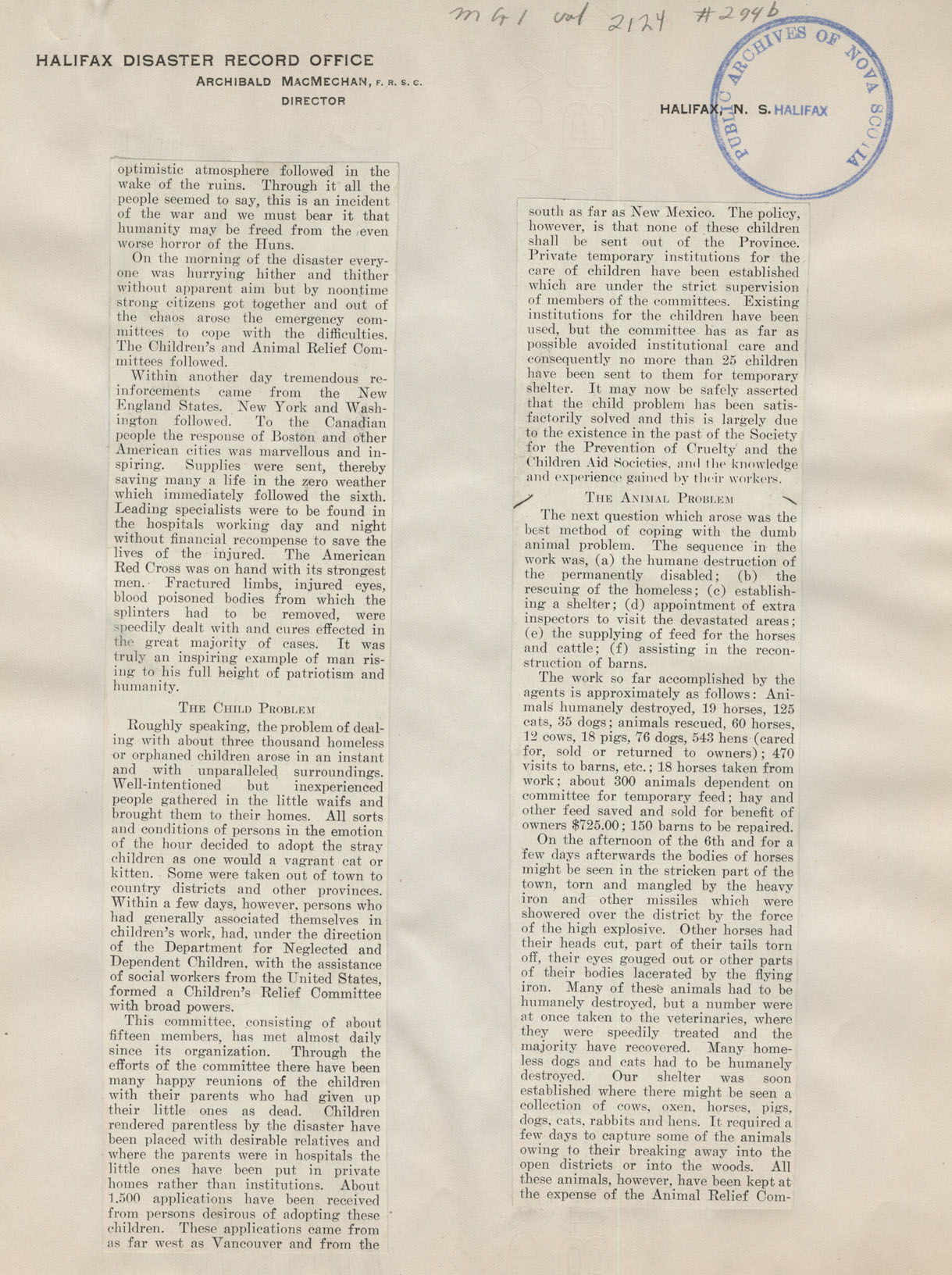Nova Scotia Archives
Archibald MacMechan
Halifax Disaster Record Office Materials
National Humane Review
February 1918. — 4 pages : 30 x 41 cm.
note: transcription publicly contributed - please contact us with comments, errors or omisions
HALIFAX DISASTER RECORD OFFICE
ARCHIBALD MACMECHAN, F. R. S. C.
DIRECTOR
HALIFAX, N. S.
optimistic atmosphere followed in the wake of the ruins. Through it all the people seemed to say, this is an incident of the war and we must bear it that humanity may be freed from the even worse horror of the Huns.
On the morning of the disaster everyone was hurrying hither and thither without apparent aim but by noontime strong citizens got together and out of the chaos arose the emergency committees to cope with the difficulties. The Children's and Animal Relief Committees followed.
Within another day tremendous reinforcements came from the New England States. New York and Washington followed. To the Canadian people the response of Boston and other American cities was marvellous and inspiring. Supplies were sent, thereby saving many a life in the zero weather which followed the sixth. Leading specialists were to be found in the hospitals working day and night without financial recompense to save the lives of the injured. The American Red Cross was on hand with its strongest men. Fractured limbs, injured eyes, blood poisoned bodies from which the splinters had to be removed, were speedily dealt with and cures effected in the great majority of cases. It was truly an inspiring example of man rising to his full height of patriotism and humanity.
THE CHILD PROBLEM
Roughly speaking, the problem of dealing with the about three thousand homeless or orphaned children arose in an instant and with unparalleled surroundings. Well-intentioned but inexperienced people gathered in the little waifs and brought them to their homes. All sorts and conditions of persons in the emotion of the hour decided to adopt the stray children as one would a vagrant cat or kitten. Some were taken out of town to country districts and other provinces. Within a few days, however, persons who had generally associated themselves in children's work, had, under the direction of the Department for Neglected and Dependent Children, with the assistance of social workers from the United States, formed a Children's Relief Committee with broad powers.
This committee, consisting of about fifteen members, has met almost daily since its organization. Through the efforts of the committee there have been many happy reunions of the children with their parents who had given up their little ones as dead. Children rendered parentless by the disaster have been placed with desirable relatives and where the parents were in hospitals the little ones have been put in private homes rather than institutions. About 1,500 applications have been received from persons desirous of adopting these children. These applications came from as far west as Vancouver and from the south as far as New Mexico. The policy, however, is that none of these children shall be sent out of the Province. Private temporary institutions for the care of children have been established which are under the strict supervision of members of the committees. Existing institutions for the children have been used, but the committee has as far as possible avoided institutional care and consequently no more than 25 children have been sent to them for temporary shelter. it may now be safely asserted that the child problem has been satisfactorily solved and this is largely due to the existence in the past of the Society for the Prevention of Cruelty and the Children Aid Societies, and the knowledge and experience gained by their workers.
THE ANIMAL PROBLEM
The next question which arose was the best method of coping with the dumb animal problem. The sequence in the work was, (a) the humane destruction of the permanently disabled; (b) the rescuing of the homeless; (c) establishing a shelter; (d) appointment of extra inspectors to visit the devastated areas; (e) the supplying of feed for the horses and cattle; (f) assisting in the reconstruction of barns.
The work so far accomplished by the agents is approximately as follows: Animals humanely destroyed, 19 horses, 125 cats, 35 dogs; animals rescued, 60 horses, 12 cows, 18 pigs, 76 dogs, 543 hens (cared for, sold or returned to owners); 470 visits to barns, etc.; 18 horses taken from work; about 300 animals dependent on committee for temporary feed; hay and other feed saved and sold for benefit of owners $725.00; 150 barns to be repaired.
On the afternoon of the 6th and for a few days afterwards the bodies of horses might be seen in the stricken part of the town, torn and mangled by the heavy iron and other missiles which were showered over the district by the force of the high explosive. Other horses had their heads cut, part of their tails torn off, their eyes gouged out or other parts of their bodies lacerated by the flying iron. Many of these animals had to be humanely destroyed, but a number were at once taken to the veterinaries, where they were speedily treated and the majority have recovered. many homeless dogs and cats had to be humanely destroyed. Our shelter was soon established where there might be seen a collection of cows, oxen, horses, pigs, dogs, cats, rabbits and hens. It required a few days to capture some of the animals owing to their breaking away into the open districts or into the woods. All these animals, however, have been kept at the expense of the Animal Relief Com-
[written at top of page]
MG 1 vol 2124 number 294b
"Halifax Needs Assistance"'; "Stricken Halifax"
Reference: Archibald MacMechan Nova Scotia Archives MG 1 volume 2124 number 294

